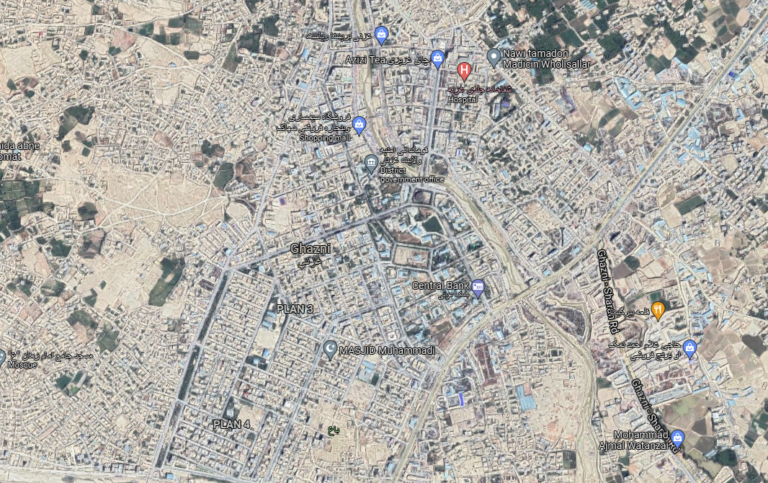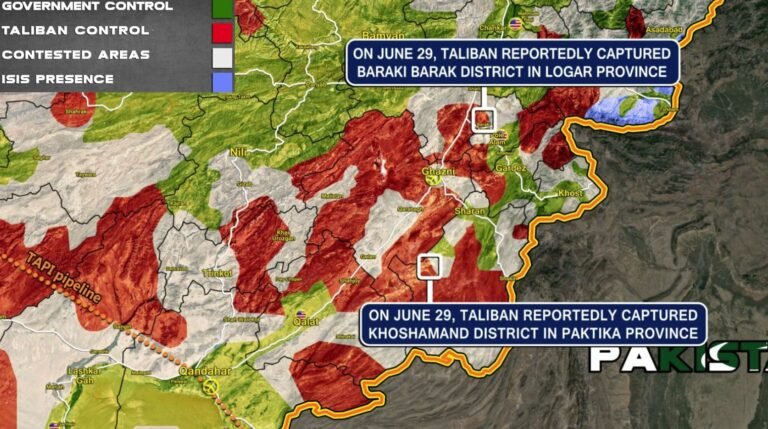Analysis of TB Attack on Ghazni Afghanistan 30-June-2021

TO NOTE: This report is being posted here for Writing example purposes. This report was written originally on the 30th of June 2021, and the intelligence in the report has lapsed and is now safe to post as all the information is now public knowledge regarding this report. This Report was compiled completely using Open Source Intelligence (OSINT) and personnel analysis
UPDATE: Kabul City fell on August 15th 2021
Historically the city of Ghazni has always conflicted, the city and region have a long history of being conquered by different tribes or factions. The Taliban got pushed out of the region by ISAF forces in the early 2000s leading to regular attacks by Taliban insurgents in the area with what seems like an attempt to take and hold the city under a Taliban Government. The most notable attack was in 2018 when the Taliban successful overthrew the city and cutting the main route from Kabul to Kandahar known as “Highway 1” a recognised strategic location of the region, requiring a counter-offensive by a joint Afghan/US force pushing the Taliban back out.
The region is a Sunni Islamic with a very small percentage being Shia, While the region is strictly Islamic, the influence of foreign militaries has brought foreign cultures, products and ideas into the region. The Taliban similar to IS (Islamic State) follows a stricter interpretation of Islam and Sharia law which would make most of foreign influences from western cultures illegal. This has been seen already in multiple other regions of the middle east as IS have been seen to destroy foreign-influenced items, such destroying sculptures, books or any form of an ideal like education of women that goes against their strict beliefs.
Successful attacks such as seen on the checkpoints could potentially be interpreted by the Taliban’s strict interpretation of the religion for success to be their “divine right”. This has been seen in the past with usage of propaganda, to recruit new members into their interpretation of Islam and insurgency.
Culturally these attacks have effects on the population of the region. Due to increased needs for security such as curfews for civilians, stop and searches for potential insurgents, mainly limiting overall activities of the population, which could cause tension between the population and the current government.
There are multiple Economic impacts of the Taliban attack, from the effects on the current Afghan government as well as effects on the population of the city. This can be in multiple factors from damage to the city infrastructure, injuries to security forces or civilians and closure of local stores due to attack damages leading to effects on the population being unable to purchase needed supplies in those areas.
Politically these attacks could look bad on the current administration and be potentially used by the Taliban for propaganda to shake the population’s support in the Afghan government’s inability to provide defence, attempting to gain the support of the population for Taliban rule. This has been seen recently as the Taliban Commander of the region Mullah Misbah has been using radio broadcasts to spread propaganda from the Taliban controlled areas. This is further negatively impacted by the fact that there has been complete radio silence from the current Afghan government countering the Taliban propaganda.
With the announcement and recent drawdown of US troops in the region, and with the recent attack on checkpoints at Ghazni. It would seem that the Taliban have been attacking certain locations such as checkpoints to potentially test the security forces responses, Potentially in preparations for a larger attack in the future.
Recent social media posts on Snapchat and Twitter show Taliban Insurgents posing for Photos and Videos at the entrance to the city. The recent attacks on the city as well as recent open source mapping data show that the Taliban have gained a strong foothold around the city, capturing other locations such as Maidan Wardak Province and an Afghan army location north of the city.
It is possible that the capture of these locations close to the city, could be in preparation for an offensive on the Ghazni city itself. Ghazni city could potentially be used as strategic staging location for an further attack on the capital Kabul. If an attack is staged from such a large city close to Kabul with similar to current fast paced attacks with high numbers as has been seen from the Taliban recently. Along with the final drawdown of US troops from the two nearby Forward Operating Bases at Pole Alam and Qalat leaving the area defended by the currently dwindling Afghan National Security Forces. The ANSF have taken heavy casualties in recent attacks for example on June 16th the Taliban allegedly shot down an Afghan Army helicopter just outside the city bringing the currently recorded deaths this year to over 660 security forces and nearly 200 civilian deaths in June.
A capture of Ghazni along with the US Withdrawal could potentially lead to this been seen as a victory and motivating others to join the Taliban as fighters, allowing them to continue the push through major areas onto Kabul as seems to be the current goal as seen by predicted controlled areas in the region showing a strong and direct push from the south to the north. With the dwindling ANSF it could be predicted that there could be a potential attack from the Taliban on Ghazni within the next week and a potential large scale offensive on Kabul leading to the fall within the next 1-2 months, this is due to the speed in which the Taliban has been moving north and the Afghan National Security Forces causalities reducing able bodied fighters to defend the capital.
